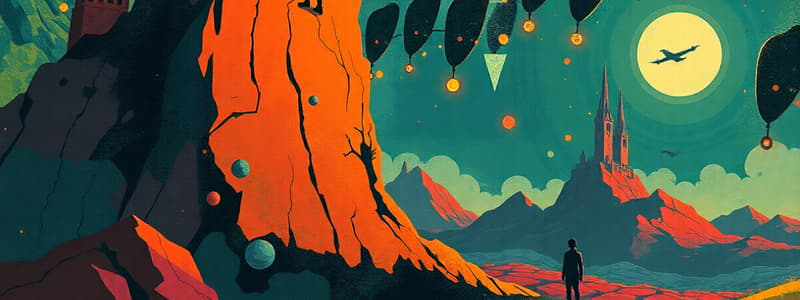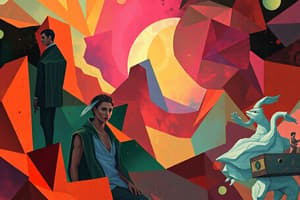Podcast
Questions and Answers
What does abstract art aim to achieve?
What does abstract art aim to achieve?
It aims to use shapes, colors, forms, and gestural marks to create its effect.
Which art movement was formed as a negative reaction to the First World War?
Which art movement was formed as a negative reaction to the First World War?
- Pop Art
- Minimalism
- Dadaism (correct)
- Surrealism
Who are some notable artists associated with Abstract Expressionism?
Who are some notable artists associated with Abstract Expressionism?
Jackson Pollock, Mark Rothko, and Willem de Kooning.
Surrealism produces realistic depictions of reality.
Surrealism produces realistic depictions of reality.
What does Minimalism in art aim to do?
What does Minimalism in art aim to do?
What is Photorealism?
What is Photorealism?
Dadaism is often described as _____ and nonsensical.
Dadaism is often described as _____ and nonsensical.
Who created 'Fountain' in 1917?
Who created 'Fountain' in 1917?
What is the primary focus of Conceptual Art?
What is the primary focus of Conceptual Art?
Which statement best describes the relationship between Pop Art and traditional fine art values?
Which statement best describes the relationship between Pop Art and traditional fine art values?
In which art movement is the essence of a subject revealed through the elimination of non-essential features?
In which art movement is the essence of a subject revealed through the elimination of non-essential features?
What defines the genre of Photorealism?
What defines the genre of Photorealism?
Which of the following artists is NOT associated with the movement of Optical Art?
Which of the following artists is NOT associated with the movement of Optical Art?
Which characteristic best defines Dadaism?
Which characteristic best defines Dadaism?
What was a key goal of Constructivism in art?
What was a key goal of Constructivism in art?
Which of the following artists is NOT associated with Abstract Expressionism?
Which of the following artists is NOT associated with Abstract Expressionism?
The technique of using unnatural or irrational combinations in art is most closely associated with which movement?
The technique of using unnatural or irrational combinations in art is most closely associated with which movement?
Optical Art is primarily known for creating an impression of what?
Optical Art is primarily known for creating an impression of what?
Which of the following statements is true about Abstract Art?
Which of the following statements is true about Abstract Art?
What does the term 'gestural brushstrokes' in Abstract Expressionism refer to?
What does the term 'gestural brushstrokes' in Abstract Expressionism refer to?
Which work exemplifies Surrealism through the use of dream-like imagery?
Which work exemplifies Surrealism through the use of dream-like imagery?
Flashcards are hidden until you start studying
Study Notes
Abstract Art
- Abstract art does not represent visual reality accurately but uses shapes, colors, forms, and markings
- Examples of Abstract art include Tableau I (1921) by Piet Mondrian and Composition X (1939) by Wassily Kandinsky
Dadaism
- This movement emerged during WWI in Zurich as a response to the war's horrors.
- Dada art, poetry, and performance are characterized by satire and nonsensical nature.
- Examples include Fountain (1917) by Marcel Duchamp and Construction for Noble Ladies (1919) by Kurt Schwitters.
- Dadaism's key figure - Marcel Duchamp, best known for his "Fountain" (1917) - a urinal presented as a work of art.
Surrealism
- Surrealism aims to create fantastic or incongruous imagery through unnatural juxtapositions and combinations in art, literature, film, and theater.
- The Persistence of Memory by Salvador Dalí is a significant example.
Constructivism
- It originated in Russia in 1915, influenced by Vladimir Tatlin and Alexander Rodchenko.
- Abstract and austere, it reflects modern industrial society and urban space.
- Examples include Tatlin's Tower (1919) by Vladimir Tatlin and Spatial Construction by Alexander Rodchenko (1920)
Abstract Expressionism
- Developed by American artists like Jackson Pollock, Mark Rothko, and Willem de Kooning in the 1940s and 1950s.
- Characterized by gestural brushstrokes, mark-making, and spontaneity.
- Examples: Number One, 1950 (Lavender Mist) by Jackson Pollock, Untitled by Jackson Pollock.
Optical Art
- Abstract art with many known black and white pieces creating the illusion of movement, hidden images, flashing, and vibrating patterns.
- Examples: Pratfall by Frank Stella, Kumo XV by Omar Rayo.
Pop Art
- Inspired by modern popular culture and mass media, often serving as a critique or ironic comment on traditional art values.
- Examples: CocaCola on Tumblr by Kunststunden, Compre in the Car by de Roy Lichtenstein.
Minimalism
- Focuses on exposing the essence of a subject by eliminating non-essential forms, features, or concepts.
- Examples: Wall Drawing, 1972 by Sol LeWitt.
Conceptual Art
- The concept or idea takes precedence over traditional aesthetic, technical, and material aspects.
- Examples: One and Three Chairs (1965) by Joseph Kosuth, I Like America and Likes Me by Joseph Beuys.
Photorealism
- Painters, drawers, and artists using other graphic media attempt to replicate photographic images as realistically as possible in other media.
- Examples: The Judgment of Paris by Charles Bell, Roll a Top by Charles Bell.
Abstract Art
- Does not accurately represent visual reality.
- Uses shapes, colors, forms and gestural marks to achieve its effect.
- Examples include: “Tableau I” by Piet Mondrian, and ”Composition X (1939)” by Wassily Kandinsky
Dadaism
- Reaction to the horrors of World War I.
- Art, poetry, and performance are often satirical and nonsensical.
- Examples include: “Fountain” by Marcel Duchamp, and “Construction for Noble Ladies” by Kurt Schwitters.
Surrealism
- Uses incongruous imagery to create fantastic effects through unnatural juxtaposition.
- Examples include: “The Persistence of Memory” by Salvador Dalí.
Constructivism
- Originated in Russia (1915) by Vladimir Tatlin and Alexander Rodchenko.
- Aims to reflect modern industrial society and urban space.
- Abstract and austere.
- Examples include: “Tatlin’s Tower” by Vladimir Tatlin, and “Spatial Construction” by Alexander Rodchenko.
Abstract Expressionism
- New form of American abstract art (1940’s and 1950’s).
- Characterized by gestural brushstrokes and spontaneity.
- Examples include: “Number One, 1950 (Lavender Mist)” and “Untitled” both by Jackson Pollock.
Optical Art
- Abstract art with an emphasis on movement, hidden images, and flashing patterns.
- Works can create the impression of warping and swelling.
- Often black and white.
- Examples include: “Pratfall” by Frank Stella, and “Kumo XV” by Omar Rayo.
Pop Art
- Based on (and critiques) modern popular culture and the mass media.
- Examples include: “CocaCola on Tumblr” by Kunststunden, and “Compre In The Car” by De Roy Lichtenstein.
Minimalism
- Exposes the essence of a subject through the elimination of non-essential forms, features, and concepts.
- Examples include: “Wall Drawing” by Sol LeWitt.
Conceptual Art
- The concept or idea involved takes precedence over aesthetic, technical, and material concerns.
- Examples include: “One and Three Chairs” and “I like America and America Likes Me” both by Joseph Kosuth.
Photorealism
- Artists study a photograph and attempt to reproduce the image as realistically as possible in another medium.
- Examples include: “The Judgment of Paris” and “Roll A Top” both by Charles Bell.
Studying That Suits You
Use AI to generate personalized quizzes and flashcards to suit your learning preferences.





